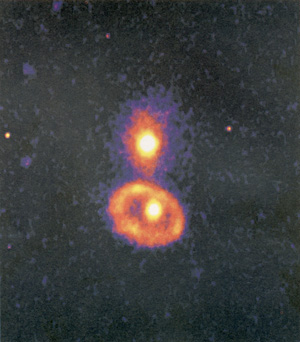

For over half a century astronomers have pondered the origin of a rare but beautiful class of galaxy, now called "ring galaxies". We believe that these peculiar galaxies, which take on the appearance of a "smoke ring" on photographic plates, are formed as a result of a cosmic accident of gargantuan proportions. An "intruder" galaxy plunges through the center of a larger rotating disk galaxy, triggering the birth of bright young stars in the wake of radially expanding ring waves. These driven oscillations, like vibrations on the surface of a pond or canal, can be thought of as perturbation experiments, but on a galactic scale. Once recognized as such, the waves can be used to probe both the shape and strength of the gravitational potential of the target galaxy, as well as the mechanisms which lead to star birth and star death in propagating density waves. The geometric simplicity of these near bulls-eye collisions, as attested by the success of even the simplest kinematic models of their evolution, make ring galaxies attractive tools for understanding galactic structure and evolution. In these "cosmic experiments", as the strength of the perturbation is increased, through successively more massive intruder galaxies, the system can be tested from the limit of small-order perturbation theory to the realm of highly non-linear behavior treated best by self-consistent numerical simulations. Although at one time thought to be rare, the collision between two galaxies is now believed to be an important mechanism in galaxy evolution. Ring galaxies in particular, may form the most tractable of a family of collisional scenario which end in merger and transmutation.
Interest in ring galaxies can be traced back to Zwicky (1941), where he presented the first photograph of the now famous "Cartwheel" ring in the constellation of Sculptor (see Figure 1 for a Hubble Space Telescope view of the Cartwheel). His photograph, obtained with an 18-inch Schmidt camera on Palomar Mountain, showed an outer ring, a faint bar and spiral streamers (often referred to as "spokes") extending from the center to the ring. Modern observations also show an inner ring. Zwicky concluded that "this represents one of the most complicated structures awaiting explanation on the basis of stellar dynamics". Indeed over half a century later, a theory for the origin of the spokes is only just emerging by considering them as gravitational instabilities in a mainly gaseous, rather than a stellar disk.

|
Figure 1. The Cartwheel ring galaxy obtained with the WFPC-II camera on the Hubble Space Telescope. The image was created by combining a B-band and an I-band image of the galaxy and an attempt has been made to balance the colors to indicate red and blue regions in the galaxy. The spatial resolution of the observations is approximately 0.1 arcseconds which corresponds to approximately 50 pc at the distance of the Cartwheel. The Cartwheel is unusual in that it contains an inner and outer ring as well as the connecting "spokes" which so perplexed F. Zwicky when he first discovered the galaxy. (Image from Borne et al. 1995). (See Color Plate I at the back of this issue.) StScI Press release. |
In the years that followed, notably with the publication of major catalogs and atlases of peculiar galaxies by Vorontsov-Velyaminov (1959), Vorontsov-Velyaminov and Krasnogorskaya (1961; MCG Catalog) and Arp (1966), more of the peculiar ring galaxies were uncovered. Lindsey and Shapley (1960) discovered a large ring in the southern sky (see also Graham (1974)). Vorontsov-Velyaminov (1960) drew attention to the class of ring galaxies and presented numerous examples in Part II of the Atlas of Interacting Galaxies (Vorontsov-Velyaminov, 1977). In the north, Mayall's Object (see Smith 1941; Burbidge, 1964) was discovered as an example of a ring with a cigarshaped object extending from the ring (Arp 148 = VV32). Sersic (1968) drew attention to another classical ring in the constellation of Vela. We present in Figures 2a to 2d a sequence of recent views of some well known ring galaxies.

|

|

|

|
Figure 2. a) The "centrally smooth" ring
galaxy VII Zw466 does not
have an obvious nucleus. This grey-scale B-band image emphasizes the
brighter isophotes and shows the knots in the ring. b) VII Zw466 is
not empty (despite its classification by Theys and Spiegel as RE type)
but is filled with a red stellar population. In this grey scale
stretch (of the same B image) the inner emission is clearly seen. Of
the three galaxies seen nearby, the large elliptical galaxy seen to
the left shows peculiar "boxy" isophotes and may be the intruder. On
the other hand new HI observations (Appleton and Charmandaris, in
preparation) link the southern (bottom) edge-on disk with the
collision. (from Appleton and Marston 1995 B-band observations from
the KPNO 2.1 m telescope). The small galaxy nearest the ring is a
background galaxy.
|
Cannon et al. (1970) discussed the class of ring galaxies appearing in the Arp atlas and the similarities between objects like Arp 146 and Arp 147 and some of the galaxies, particularly I Zw 45 (= NGC 4774; incorrectly named I Zw44 by Cannon) and VII Zw 466, found in the unpublished lists of Zwicky (see Sargent 1970). These authors were the first to note that ring galaxies are blue and that many of them appear to have close companions. Photographs of I Zw 45 showed a trail of material between the ring and the companion, strongly suggesting a causal connection. Their paper ends with a question which set the scene for the next ten years of work on ring galaxies: "Do ring-shaped equilibria exist and if so, are they stable, or are rings merely an ephemeral phenomenon?". Models strongly supporting the transient nature of the ring morphologies were quick to follow, although we shall see that the question of the stability of the ring wave, especially in the gas phase, is still of considerable interest today. A short review article on ring galaxies is presented by Dennerfeld and Materne (1980).